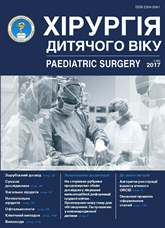The modified martinez–ferro method in pectus carinatum treatment in children
DOI:
https://doi.org/10.15574/PS.2017.55.19Keywords:
pectus carinatum, nonoperative treatment, dynamic compression bracing, protrusion of ribs and costal cartilagesAbstract
The analysis of the 36 patient management with pectus carinatum during the period from November 2015 till March 2017 is presented in the article. The dynamic compression bracing of the own design was employed in 31 patients. In all cases with completed course of treatment, we observed the full recovery. In the cases with incompleted course of deformity repair, the positive trend is determined and the patients are continuing the treatment. Several advantages of the own design of dynamic compression bracing are singled out. The similar brace for correcting the accompaned protrusion of ribs and costal cartilages is proposed.References
Pohorilyi VV, Kukuruza YuP, Loiko YeIe et al. (2011). Likuvannia vrodzhenoi kilepodibnoi deformatsii hrudnoi klitky ta pochatkovykh stadii skoliozu u ditei. Aktualni problemy diahnostyky, likuvannia ta reabilitatsii ditei z travmamy ta zakhvoriuvanniamy oporno-rukhovoho aparatu. Materialy nauk-prakt konf z mizhnar uch, 14–15 kvit 2011 r, Kyiv: 161.
Shulga DI, Loyko EE, Sasyuk AI, Dobrovanov AE. (2010). Maloinvazivnyiy sposob peredney plastiki – novyiy metod lecheniya vrozhdennoy kilevidnoy deformatsii grudnoy kletki u detey. Novyie tehnologii v pediatrii i detskoy hirurgii. Materialyi Respublikanskoy nauch-prakt konf, Alushta, 28–29 okt 2010 g.
Pohorilyi VV Sasiuk AI, Loiko YeIe et al. (2015). Rezultaty zastosuvannia maloinvazyvnoi khirurhii pry likuvanni vrodzhenoi kilepodibnoi deformatsii hrudnoi klitky u ditei. Torakalna khirurhiia Ukrainy sohodni: vyklyky ta shliakhy yikh podolannia. Materialy sympoziumu z mizhnar uch, prysviachenoho 40-richchiu zasnuvannia kafedry torakalnoi khirurhii i pulmonolohii NMAPO im PL Shupyka, 1–2 zhovt 2015 r, Kyiv: 50–51.
Abramson H, D’Agostino J, Wuscovi S. (2009). A 5-year experience with a minimally invasive technique for pectus carinatum repair. J Pediatr Surg. 44: 118–124.
Shamberger RC, Welch KJ, Castaneda AR et al. (1988). Anterior chest wall deformities and congenital heart disease. Jour Thorac Cardiovasc Surg. 96: 427–432.
Seock Yeol Lee, Seung Jin Lee, Cheol Woo Jeon et al. (2008). Effect of the compressive brace in pectus carinatum. European Journal of Cardio-thoracic Surgery. 34: 146–149. https://doi.org/10.1016/j.ejcts.2008.04.012; PMid:18479931
Fonkalsrud EW. (2008). Surgical correction of pectus carinatum: lessons learned from 260 patients. J Pediatr Surg. 43: 1235–1243. https://doi.org/10.1016/j.jpedsurg.2008.02.007; PMid:18639675
Haje SA, Bowen JR. (1992). Preliminary results of orthotic treatment of pectus deformities in children and adolescents. J Pediatr Orthop. 12(6): 795–800. https://doi.org/10.1097/01241398-199211000-00018; PMid:1452753
Martinez-Ferro M, Fraire C, Bernard S. (2008). Dynamic compression system for the correction of pectus carinatum. Semin Pediatr Surg. 17: 194–200. https://doi.org/10.1053/j.sempedsurg.2008.03.008; PMid:18582825
Martinez-Ferro M. (2012). International innovations in pediatric minimally invasive surgery: the Argentine experience. J Pediatr Surg. 47: 825–35. https://doi.org/10.1016/j.jpedsurg.2012.01.030; PMid:22595556
Scharschmidt K, Kolberg–Schwerdt A, Lempe M, Schlesinger F. (2006). New endoscopic minimal access pectus carinatum repair using subpectoral carbon dioxide. Ann Thorac Surg. 81: 1099–1104. https://doi.org/10.1016/j.athoracsur.2005.10.042; PMid:16488731
Frey AS, Garcia VF, Brown RL et al. (2006). Nonoperative management of pectus carinatum. Journal of Pediatric Surgery: 40–45. https://doi.org/10.1016/j.jpedsurg.2005.10.076; PMid:16410105
Marcelo Martinez-Ferro, Gaston Bellia Munzon, Carlos Fraire [et al.] (2016, March). Non-surgical treatment of pectus carinatum with the FMF® Dynamic Compressor System. Journal of Visualized Surgery.
Oguz Ates, Osman Z. Karakus, Gulce Hakguder et al. (2013). Pectus carinatum: the effects of orthotic bracing on pulmonary function and gradual compression on patient compliance. European Journal of Cardio-Thoracic Surgery: 1–5.
Steinmann C, Krille S, Mueller A et al. (2011). Pectus excavatum and pectus carinatum patients suffer from lower quality of life and impaired body image: a control group comparison of psychological characteristics prior to surgical correction. Eur J Cardiothorac Surg. 40: 1138–45. https://doi.org/10.1016/j.ejcts.2011.02.019
Manuel Lopez, Arnaud Patoira, Francois Varleta et al. (2013). Preliminary study of efficacy of dynamic compression system in the correction of typical pectus carinatum. European Journal of Cardio-Thoracic Surgery. 44: 316–319. https://doi.org/10.1093/ejcts/ezt425; PMid:24014551
Robicsek F, Fokin AA. (2004). How not to do it: restrictive thoracic dystrophy after pectus excavatum repair. Interact Cardio-Vasc and Thorac Surg. 3: 566–568. https://doi.org/10.1016/j.icvts.2004.06.007; PMid:17670312
Cohee AS, Lin JR, Frantz FW et al. (2013). Staged management of pectus carinatum. J Pediatr Surg. 48: 315–20. https://doi.org/10.1016/j.jpedsurg.2012.11.008; PMid:23414858
Kravarusic D, Dicken BJ, Dewar R et al. (2006). The Calgary protocol for bracing of pectus carinatum: a preliminary report. J Pediatr Surg. 41: 923–6. https://doi.org/10.1016/j.jpedsurg.2006.01.058; PMid:16677884
Welch KJ, Randolph JG, Ravitch MM et al. (1986). The chest wall. Pediatric Surgery. 4 th Edition. New York (NY): 578–561.
Downloads
Issue
Section
License
The policy of the Journal “PAEDIATRIC SURGERY. UKRAINE” is compatible with the vast majority of funders' of open access and self-archiving policies. The journal provides immediate open access route being convinced that everyone – not only scientists - can benefit from research results, and publishes articles exclusively under open access distribution, with a Creative Commons Attribution-Noncommercial 4.0 international license(СС BY-NC).
Authors transfer the copyright to the Journal “PAEDIATRIC SURGERY.UKRAINE” when the manuscript is accepted for publication. Authors declare that this manuscript has not been published nor is under simultaneous consideration for publication elsewhere. After publication, the articles become freely available on-line to the public.
Readers have the right to use, distribute, and reproduce articles in any medium, provided the articles and the journal are properly cited.
The use of published materials for commercial purposes is strongly prohibited.

